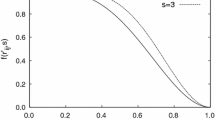Abstract
A mixed QM/MM computer program coupling Amber and Mrcc is presented. This is the first implementation of the Huzinaga equation-based local self-consistent field (HLSCF) method that makes it possible to calculate ab initio wave functions without orthogonalizing the basis set to the frozen orbitals separating the QM and MM subsystems. A significant novelty of the program is that it includes an automatic generation of the frozen localized orbitals obtained from calculations performed for model molecules cut out of the system. The Amber–Mrcc code also allows the use of the link atom (LA) approach. Sample calculations were performed to check the performance of both the HLSCF and the LA approaches by describing the interactions between the QM and MM subsystems with electrostatic embedding. It was found that the conceptually appealing HLSCF method is a competitive alternative to the LA method.








Similar content being viewed by others
References
Náray-Szabó G, Surján P (1983) Chem Phys Lett 96:499–501
Ferenczy GG, Rivail JL, Surján PR, Náray-Szabó G (1992) J Comput Chem 13:830–837
Náray-Szabó G, Surján P (1985) Theochem 123:85–95
Warshel A, Levitt M (1976) J Mol Biol 103:227–249
Théry V, Rinaldi D, Rivail JL, Maigret B, Ferenczy GG (1994) J Comput Chem 14:269–282
Philipp DM, Friesner RA (1999) J Comput Chem 20:1468–1494
Murphy RB, Philipp DM, Friesner RA (2000) J Comput Chem 21:1442–1457
Gao J, Amara P, Alhambra C, Field MJ (1998) J Phys Chem A 102:4714–4721
Pu J, Gao J, Truhlar DG (2004) J Phys Chem A 108:632–650
Reuter N, Dejaegere A, Maigret B, Karplus M (2000) J Phys Chem A 104:1720–1735
Assfeld X, Rivail JL (1996) Chem Phys Lett 263:100–106
Ferenczy GG (2013) J Comput Chem 34:862–869
Ferenczy GG (2013) J Comput Chem 34:854–861
Huzinaga S, Cantu AA (1971) J Chem Phys 55:5543–5549
Huzinaga S (1995) Can J Chem 55:619–628
Case DA, Babin V, Berryman JT, Betz RM, Cai Q, Cerutti DS, Cheatham TE III, Darden TA, Duke RE, Gohlke H, Goetz AW, Gusarov S, Homeyer N, Janowski P, Kaus J, Kolossváry I, Kovalenko A, Lee TS, LeGrand S, Luchko T, Luo R, Madej B, Merz KM, Paesani F, Roe DR, Roitberg A, Sagui C, Salomon-Ferrer R, Seabra G, Simmerling CL, Smith W, Swails J, Walker RC, Wang J, Wolf RM, Wu X, Kollman PA (2014) AMBER 14. University of California, San Francisco
Salomon-Ferrer R, Case AA, Walker RC (2013) WIREs Comput Mol Sci 3:198–210
Mrcc, a quantum chemical program suite written by Kállay M, Rolik Z, Csontos J, Ladjánszki I, Szegedy L, Ladóczki B, Samu G See also Rolik Z, Szegedy L, Ladjánszki I, Ladóczki B, Kállay M (2013) J Chem Phys 139:094105, as well as: http://www.mrcc.hu
Woodcock HL, Hodosceck M, Gilbert ATB, Gill PMW, Schaefer HF, Brooks BR (2007) J Comput Chem 28:1485–1502
Torras J, Seabra GM, Deumens E, Trickey SB, Roitberg AE (2008) J Comput Chem 29:1564–1573
Hagiwara Y, Ohta T, Tateno M (2009) J Phys Condens Matter 21:064234
Metz S, Kästner J, Sokol AA, Keal TW, Sherwood P (2014) WIREs Comput Mol Sci 4:101–110
Götz W, Clark MA, Walker RC (2014) J Comput Chem 35:95–108
Riahi S, Rowley CN (2014) J Comput Chem 35:2076–2086
Loos P-F, Fornili A, Sironi M, Assfeld X (2007) Comput Lett 3:473–486
Monari A, Rivail J-L, Assfeld S (2013) Acc Chem Res 46:596–603
Monari A, Assfeld X (2001) In: Gorb L, Kuzmin V, Muratov E (eds) Application of computational techniques in pharmacy and medicine. Springer, New York
Cornell WD, Cieplak P, Bayly CI, Gould IR, Merz KM Jr, Ferguson DM, Spellmeyer DC, Fox T, Caldwell JW, Kollman PA (1995) J Am Chem Soc 117:5179–5197
Boys SF (1960) Rev Mod Phys 32:296–299
Pipek J, Mezey P (1989) J Chem Phys 90:4916–4926
Boughton JW, Pulay P (1993) J Comput Chem 14:736–740
Hehre WJ, Ditchfield R, Pople JA (1972) J Chem Phys 56:2257–2261
Wang J, Wolf RM, Caldwell JW, Kollman PA, Case DA (2004) J Comput Chem 25:1157–1174
Wang J, Wang W, Kollman PA, Case DA (2006) J Mol Graph Model 25:247–260
Jakalian A, Bush BL, Jack DB, Bayly CI (2000) J Comput Chem 21:132–146
Jakalian A, Jack DB, Bayly CI (2002) J Comput Chem 23:1623–1641
Schrödinger Release 2015–1: Maestro, version 10.1, Schrödinger, LLC, New York, NY, 2015
Williams T, Kelley C (2013) Gnuplot: an interactive plotting program. http://www.gnuplot.info. Last Accessed 10 Dec 13
Marvin was used for drawing and displaying chemical structures, Marvin 9.22.0, 2014, ChemAxon. http://www.chemaxon.com
Acknowledgments
This paper is dedicated to Professor Péter R. Surján on the happy occasion of his sixtieth birthday. M.K. expresses his gratitude to Professor Surján for mentoring him at the early stages of his career and for continuous support. G.G.F. is grateful to Professor Peter R. Surjan for his contribution to creating a highly motivating research atmosphere and for his friendly support the author enjoyed as a PhD student. The computing time granted on the Hungarian HPC Infrastructure at NIIF Institute is gratefully acknowledged. The research work has been accomplished in the framework of the “BME R+D+I project,” supported by the grant TÁMOP 4.2.1/B-09/1/KMR-2010-0002. The authors are grateful for the financial support from the Hungarian Scientific Research Fund (OTKA, Grant No. K111862).
Author information
Authors and Affiliations
Corresponding author
Additional information
Published as part of the special collection of articles “Festschrift in honour of P. R. Surjan”.
Electronic supplementary material
Below is the link to the electronic supplementary material.
Rights and permissions
About this article
Cite this article
Hégely, B., Bogár, F., Ferenczy, G.G. et al. A QM/MM program using frozen localized orbitals and the Huzinaga equation. Theor Chem Acc 134, 132 (2015). https://doi.org/10.1007/s00214-015-1734-3
Received:
Accepted:
Published:
DOI: https://doi.org/10.1007/s00214-015-1734-3




